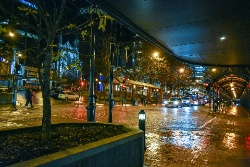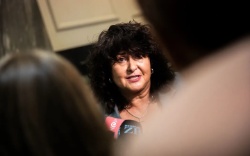Rena Recovery Newsletter – Issue 7
Rena Recovery Newsletter – Issue 7
December Update
This
month Massey University provides an update on the breeding
season for little blue penguins, NIWA has been searching for
foreign species in Tauranga Harbour, and there’s
information on oil, with an update for beach
goers.
Nga mihi o te Kirihimete me te Tau Hou
ki a koutou
Nga
Manaakitanga
(Merry Christmas and Happy New Year to you all - all the blessings)
Click here to download a print friendly version
Little blue penguins breeding
The Massey University penguin
monitoring programme is going well, with signs that the
once-oiled penguins are now successfully breeding.
Massey University Masters student Karin
Sievwright is overseeing the project, with field assistance
from local volunteers.
“So far the penguins seem to be doing quite well, with nearly all the burrows we have encountered having two eggs in them, which is a good sign,” Karin said.
“A lot of these eggs are hatching and we are monitoring chicks of varying ages, with some new-born, some developing adult feathers, some near fledging and a handful already fledged”.
It is still early days for the monitoring project and the team will continue to track micro-chipped penguin’s whereabouts over summer.
If you are keen to volunteer and become a part of the Mount Penguin Monitoring Group search 'Mount Penguin Monitoring' on Facebook and post a message.
The project focuses on Mauao (Mount Maunganui), Moturiki (Leisure Island) and Motuotau (Rabbit Island) and will run through the 20122013 breeding season until at least March 2013.
If you find a dead penguin on the beach between Waihī and Maketū please report it by calling 021 719 622 so that it can be checked for a microchip and be sent to Massey University for a post mortem examination if necessary.
Our beaches are looking great!
Oil information
We
encourage you to go out and enjoy our beautiful Bay of
Plenty beaches. Thanks to the amazing clean-up efforts of
volunteers and oil spill response teams our beaches are
looking great.
We need to be aware that the environment is still recovering from an oil spill, but there is likely to be little evidence of this when swimming and spending time on the beach.
If you do discover a spot of oil it will mostly be a nuisance if it sticks to your clothes or beach towel. Use warm soapy water to remove any oil.
Where and when oil is more likely to
resurface
Small spots of oil are most likely to appear along the stretch of coast between Ōmanu and Maketū in the Bay of Plenty because these areas were most heavily affected by the Rena oil spill.
The weather and ocean swell is a good indicator for when oil spots are more likely to appear. Storms and large swells have resulted in more sightings of oil spots, particularly north-easterly storms.
Oil and your
health
Toi Te Ora - Public Health Service advise that there are no on-going, appreciable health risks associated with the Rena oil spill in October 2011. However, if you do see any oil, avoid contact with it and report it to the pollution hotline (0800 884 883).
Based on sampling and risk assessment advice, finfish and crayfish are considered safe to eat. A shellfish monitoring programme has shown there is now no appreciable food safety risk from the Rena oil spill. However, there is currently a health warning in place advising against the collection and consumption of shellfish as they may be affected by an unrelated natural toxin that can cause Paralytic Shellfish Poisoning (PSP).
For more information go to the Toi Te Ora - Public Health Service website
Community initiatives help
wildlife affected by Rena
The Rena Recovery
wildlife programme is supporting a number of community
projects that aim to sustain the populations of wildlife
affected by the Rena grounding. Projects include pest animal
control and off-shore island checks for invasive pest animal
species. No pest incursions have been identified so far on
either Karewa Island or Tūhua (Mayor Island).
Click here to view the full report >>
Checking for oil
Shoreline Monitoring Report
A number of shorelines have been surveyed recently to see if spots of weathered oil are still visible along beaches and rocky shores.
Rena Recovery Manager Catherine Taylor said that the surveys indicated there is very little oil remaining along our shorelines, and the oil spots that were found were weathered and breaking down well in the environment as expected.
The survey was conducted along the shorelines of Tauranga Harbour, Mauao, Ōmanu, Pāpāmoa and Motuotau (Rabbit Island). The next observation survey will be carried out in February 2013, and the Monitoring Programme will continue over summer to sample and test for oil to contribute to a greater understanding of the presence of oil in the environment.
Click here to view the full report >>
Increasing vigilance for unwanted
species
Harbour checked for crabs and
other species.
The Sea Tow 60 barge was brought to New Zealand from Australia under urgency to help with the Rena response in October 2011. The hull of the barge was not cleaned properly and it is possible that there were foreign organisms on this barge that may have entered New Zealand waters.
NIWA was contracted by Rena Recovery to check locations in and around Tauranga Harbour for any foreign species that may have come off this barge.
In September, NIWA expanded its bi-annual survey for marine pests in Tauranga Harbour to incorporate specific checks. More than 280 samples were collected, but none of these samples were foreign species from the barge.
In early November, NIWA teamed up with students from Te Māuri Moana Tertiary Partnership to survey four mangrove forests in Tauranga Harbour for crabs found on the Sea Tow 60. They captured more than 1800 native crabs in pitfall traps (small, buried traps that the crabs fall into while scuttling around). Thankfully, there was no sign of the foreign crab, and the native crabs were released back into the mangroves.
NIWA has this month been contracted to extend surveillance for unwanted marine pests to Otaiti (Astrolabe Reef) and Mōtītī Island. This work will get underway over the coming months.
www.renarecovery.org.nz
Click here to explore our website for more
information and detail >>
If you have any questions please email us at info@renarecovery.org.nz
ENDS


 Gordon Campbell: On The Hamas Ceasefire Offer, And Mark Mitchell’s Incompetence
Gordon Campbell: On The Hamas Ceasefire Offer, And Mark Mitchell’s Incompetence Wellington Office of the Mayor: Mayor Responds To Housing Minister’s District Plan Decision
Wellington Office of the Mayor: Mayor Responds To Housing Minister’s District Plan Decision Stats NZ: Have Your Say On Modernising The Census
Stats NZ: Have Your Say On Modernising The Census NZ Government: Therapeutic Products Act To Be Repealed
NZ Government: Therapeutic Products Act To Be Repealed The Treasury: Interim Financial Statements Of The Government For Nine Months Ended 31-3-2024
The Treasury: Interim Financial Statements Of The Government For Nine Months Ended 31-3-2024  Government: New Zealand Sign Language Week An Opportunity For Anyone To Sign
Government: New Zealand Sign Language Week An Opportunity For Anyone To Sign ACT New Zealand: Investment In Prisons Delivers On ACT Commitment
ACT New Zealand: Investment In Prisons Delivers On ACT Commitment


